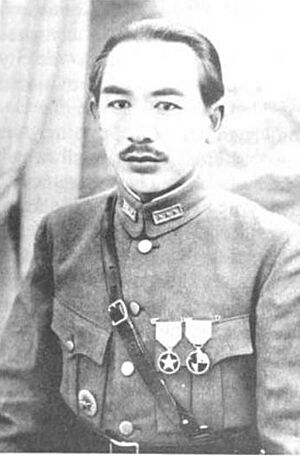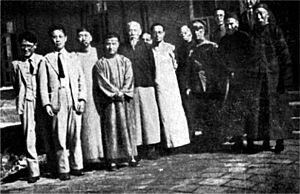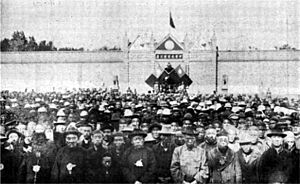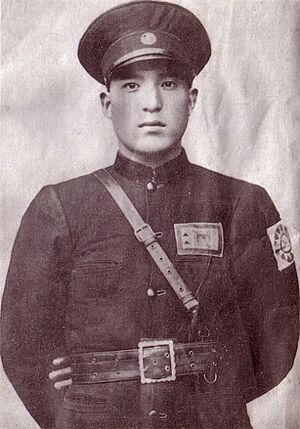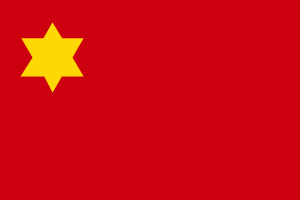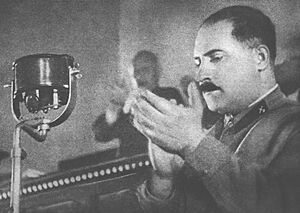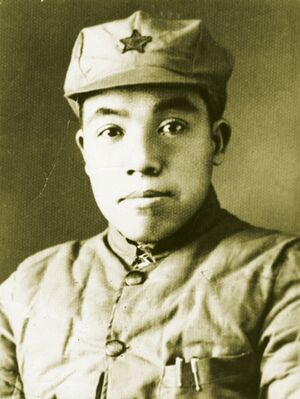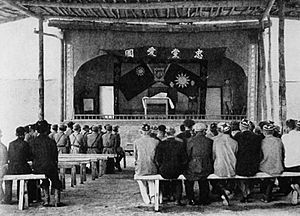Sheng Shicai facts for kids
Quick facts for kids
Sheng Shicai
|
|
|---|---|
|
盛世才
|
|
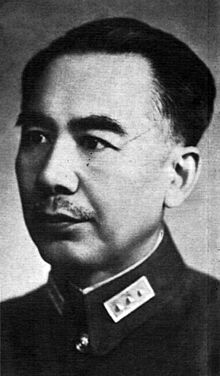
Governor Sheng Shicai in the National Revolutionary Army general's uniform
|
|
| Minister of Agriculture and Forestry | |
| In office 29 August 1944 – 30 July 1945 |
|
| President | Chiang Kai-shek |
| Prime Minister | Chiang Kai-shek (to 1945) Soong Tse-ven (1945) |
| Duban (Military Governor) of Xinjiang | |
| In office 14 April 1933 – 29 August 1944 |
|
| Preceded by | Jin Shuren (as Commander-in-Chief) |
| Succeeded by | Office abolished |
| Provincial Chairman of Xinjiang | |
| In office 4 April 1940 – 29 August 1944 |
|
| Preceded by | Li Rong |
| Succeeded by | Wu Zhongxin |
| Personal details | |
| Born | 3 December 1895 Kaiyuan, Manchuria, Qing Empire |
| Died | 13 July 1970 (aged 74) Tri-Service General Hospital, Taipei, Republic of China |
| Cause of death | Intracerebral hemorrhage |
| Nationality | Han Chinese |
| Political party | Kuomintang (1942–70) |
| Other political affiliations |
People's Anti-Imperialist Association (1935–42) Communist Party of the Soviet Union (1938–42) |
| Spouse | Qiu Yufang |
| Relations | Guo Songling (father-in-law) Yu Xiusong (brother-in-law) |
| Children | 4 |
| Alma mater | Imperial Japanese Army Academy |
| Nickname | King of Xinjiang |
| Military service | |
| Allegiance | |
| Branch/service | |
| Years of service | 1919–49 |
| Rank | General |
| Commands | |
| Battles/wars |
|
Sheng Shicai (Chinese: 盛世才; pinyin: Shèng Shìcái; Wade–Giles: Sheng Shih-ts'ai; 3 December 1895 – 13 July 1970) was a powerful Chinese leader, sometimes called a warlord, who controlled the region of Xinjiang from 1933 to 1944. He became the Military Governor of Xinjiang after a sudden change in leadership in 1933.
Sheng Shicai was born in Manchuria and studied in Tokyo, Japan. He was interested in Marxism from a young age and took part in the May Fourth Movement in 1919, which was a protest against foreign influence in China. He also served in the Northern Expedition, a military campaign by the Kuomintang (China's Nationalist Party) to unite the country. During his time in power, Sheng Shicai was sometimes called the "King of Xinjiang."
Contents
Early Life and Military Career
Sheng Shicai was born into a well-off farming family in Kaiyuan, Manchuria, on December 3, 1895. He went to school in Shanghai and Tokyo, where he studied political economy. He became interested in nationalist ideas and Marxism during this time.
After his studies, Sheng decided to join the military. He trained in Kwantung and then attended the Northeastern Military Academy. He quickly rose through the ranks, becoming a Staff Officer and company commander. His good service helped him get into the Imperial Japanese Army Academy for more advanced military training.
In 1927, Sheng returned to China to join the Northern Expedition. He served as a colonel and proved himself to be a capable officer. He was part of the Guominjun, a group that supported the Nationalist government. Although he believed in Marxism, he did not join the Kuomintang at this time. After the expedition, he worked in Nanjing but resigned in 1929 due to disagreements. He then focused on strengthening China's border defenses.
Rise to Power in Xinjiang
In 1929, Sheng Shicai was invited to work for Jin Shuren, the Governor of Xinjiang. He became the Chief of Staff for the Frontier Military and a main instructor at the Provincial Military College.
Xinjiang was facing a rebellion, known as the Kumul Rebellion. In April 1933, Governor Jin was overthrown in a sudden change of power. Sheng Shicai returned to the capital, Ürümqi, and was appointed Military Governor of Xinjiang on April 14, 1933.
Dealing with Rivals
Sheng's new position was not easy. He faced challenges from other powerful figures like Ma Zhongying and Zhang Peiyuan. The Chinese government also tried to gain more control over Xinjiang.
In June 1933, a government official named Huang Musong arrived in Ürümqi. Sheng suspected that Huang was trying to remove him from power. Sheng used rumors to claim that Huang was plotting against the government. Huang was briefly placed under house arrest, and some of the original coup leaders were arrested and executed. After the Chinese government promised to recognize Sheng's position, Huang was allowed to leave.
Later, in August, the Chinese government sent Foreign Minister Luo Wengan to Xinjiang. While Luo was there to officially recognize Sheng, he also secretly met with Sheng's rivals, Ma and Zhang, encouraging them to attack Sheng. As soon as Luo left, fighting broke out. Sheng accused Luo of plotting against him.
Sheng then removed the Civil Governor, Liu Wenlong, replacing him with someone he could control better.
Soviet Support
Facing attacks from Ma's army, Sheng asked the Soviet Union for help. In December 1933, Soviet officials arrived, and the Soviets began providing military aid. In return, Sheng gave the Soviets significant control over Xinjiang's politics, economy, and military.
With Soviet help, Sheng's forces defeated Ma's army in January 1934. Ma's forces retreated south. The Soviets refused to hand Ma over to Sheng, keeping him as a way to influence Sheng if needed. By September 1934, a truce was agreed upon, and Sheng had largely secured his power.
Governing Xinjiang
Sheng Shicai's rule in Xinjiang was heavily influenced by the Soviet Union. He introduced a political program called the "Six Great Policies" in December 1934. These policies included:
- Anti-imperialism (against foreign control)
- Friendship with the Soviet Union
- Equality for all ethnic groups
- Clean government
- Peace
- Reconstruction (building up the province)
Sheng saw these policies as a way to apply Marxism, Leninism, and Stalinism to Xinjiang's unique situation. He even adopted a new flag for Xinjiang with a six-pointed star representing these policies.
In 1935, Sheng created the People's Anti-Imperialist Association in Ürümqi. This group helped strengthen the Soviet Union's influence in Xinjiang. Its members included people from various ethnic backgrounds, like Han Chinese, Hui, and different Turkic peoples.
Ethnic Policies
Xinjiang was home to many different ethnic groups, with Han Chinese being a small minority. Sheng adopted a policy similar to the Soviet Union's, aiming for equality among all groups. For the first time, non-Han people were included in the provincial government.
He promoted the idea that Xinjiang had 14 distinct ethnic groups, including Uyghurs, Mongols, Kazakhs, and Hui (Muslims). He encouraged the creation of cultural societies for each group. Sheng's policies also involved setting up schools for Turkic languages, publishing newspapers in these languages, and encouraging both Han Chinese to learn Uyghur and Uyghurs to learn Mandarin.
However, some Pan-Turkic activists disagreed with Sheng's policies, especially his decision to call the Turkic people of Xinjiang "Uyghur people." They preferred the name "Turkic nationality."
Soviet Economic Influence
The Soviet Union provided significant financial and material help to Xinjiang. They gave loans at low interest rates and sent many experts and advisors. This strengthened Sheng's government.
The Soviets had a strong hold on Xinjiang's trade. They imported raw materials like cotton, wool, and oil from Xinjiang. They also helped build roads and improve transportation links between Xinjiang and the Soviet Union. For example, a major road connecting Xinjiang to the Soviet Union and other parts of China was built, with thousands of Soviet citizens working on it.
The Soviets also explored for minerals like tin, tungsten, and molybdenum in Xinjiang. In 1938, oil fields were discovered, and a joint Soviet-Xinjiang oil company was formed.
Purges and Control
During 1937 and 1938, Sheng carried out his own purges, similar to the Great Purge happening in the Soviet Union. He targeted people he considered "traitors," "enemies of the people," and "spies." Many Uyghur and Hui political leaders were arrested or executed. The Soviet secret police, the NKVD, supported these actions. It is believed that many people were affected during this time.
In 1938, Sheng secretly joined the Communist Party of the Soviet Union. He also invited members of the Chinese Communist Party (CCP) to work in his administration, filling important roles in finance, education, and culture. Among them was Mao Zemin, the younger brother of Mao Zedong.
Shifting Alliances
From 1934 to 1942, Sheng's government had little contact with the Nationalist government of China, led by Chiang Kai-shek. However, when Germany invaded the Soviet Union in 1941, Sheng saw an opportunity to change his alliances. He began to distance himself from the Soviets and the CCP and tried to improve his relationship with the Chinese Nationalist government in Chongqing.
In July 1941, Sheng allowed a Chinese diplomat to visit Xinjiang. In March 1942, Sheng's brother, Sheng Shiqi, was mysteriously killed. Some believe the Soviets were involved, while others think Sheng Shicai himself was responsible due to his brother's close ties to Moscow. After this, Sheng intensified his actions against the CCP members in Xinjiang.
In July 1942, a large delegation from the Chinese government arrived in Ürümqi at Sheng's invitation. Chiang Kai-shek made it clear to the Soviet ambassador that the Chinese government would now handle all matters in Xinjiang.
The Chinese Nationalist Party, the Kuomintang, began to establish its presence throughout Xinjiang, replacing Sheng's Anti-Imperialist Association. Sheng was appointed the head of the provincial Kuomintang.
In October 1942, Sheng demanded that all Soviet military and technical personnel leave Xinjiang within three months. This was a difficult demand for the Soviets, who were fighting a major war and needed Xinjiang's oil. The Soviets eventually withdrew their personnel by March 1943.
With the Soviets gone, the Kuomintang's influence grew. In June 1943, Chinese Nationalist army divisions were moved into Xinjiang. In September, Sheng ordered the arrest and execution of CCP members, including Mao Zemin, Mao Zedong's brother.
Later Life and Retirement
As the tide of World War II turned against Germany, Sheng tried to switch back to a pro-Soviet policy. He arrested Kuomintang officials, claiming they were Japanese spies, and told Stalin they were communists. However, Stalin refused to help him.
The Chinese Nationalist government then worked to remove Sheng from power. Zhu Shaoliang convinced him to resign and accept a less important role as Minister of Agriculture. Sheng officially resigned on August 29, 1944, and left Xinjiang on September 11, 1944, to join the Chinese government in Chongqing.
Sheng's time in Chongqing was difficult. In April 1945, his former Finance Minister was attacked in Ürümqi and sought refuge with Sheng. Despite calls for his punishment, Chiang Kai-shek defended Sheng. Sheng held his ministerial post until July 1945 and later worked as an advisor.
In 1949, when the Kuomintang lost the Chinese Civil War, Sheng fled to Taiwan with the rest of the party. He lived a comfortable retirement in Taiwan with his wife and four children until his death in Taipei in 1970. He also wrote about his experiences in a book titled Red failure in Sinkiang.
Images for kids


